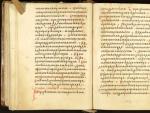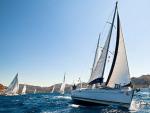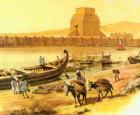What is an atmospheric vortex? Geography. Basic patterns of formation of atmospheric vortices
The struggle between warm and cold currents, trying to equalize the temperature difference between north and south, occurs with varying success. Then the warm masses take over and penetrate in the form of a warm tongue far to the north, sometimes to Greenland, Novaya Zemlya and even to Franz Josef Land; then masses of Arctic air in the form of a giant “drop” break through to the south and, sweeping away warm air on their way, fall on Crimea and the republics Central Asia. This struggle is especially pronounced in winter, when the temperature difference between north and south increases. On synoptic maps northern hemisphere You can always see several tongues of warm and cold air penetrating to different depths to the north and south.
The arena in which the struggle of air currents unfolds falls precisely on the most...
Introduction. 2
1. Formation of atmospheric vortices. 4
1.1 Atmospheric fronts. Cyclone and anticyclone 4
1.2 Approach and passage of cyclone 10
2. Study of atmospheric vortices at school 13
2.1 Studying atmospheric vortices in geography lessons 14
2.2 Study of the atmosphere and atmospheric phenomena from 6th grade 28
Conclusion.35
List of used literature.
Introduction
Introduction
Atmospheric vortices - tropical cyclones, tornadoes, storms, squalls and hurricanes.
Tropical cyclones are vortices with low pressure at the center; they happen in summer and winter. Tropical cyclones occur only at low latitudes near the equator. In terms of destruction, cyclones can be compared with earthquakes or volcanoes.
The speed of cyclones exceeds 120 m/s, with heavy cloudiness, showers, thunderstorms and hail. A hurricane can destroy entire villages. The amount of precipitation seems incredible in comparison with the intensity of rainfall during the most severe cyclones in mid-latitudes.
A tornado is a destructive atmospheric phenomenon. This is a huge vertical vortex several tens of meters high.
People cannot yet actively fight tropical cyclones, but it is important to prepare in time, whether on land or at sea. For this purpose, meteorological satellites are kept on watch around the clock, providing great help in forecasting the paths of tropical cyclones. They photograph the vortices, and from the photograph they can quite accurately determine the position of the center of the cyclone and trace its movement. Therefore, in lately managed to warn the population about the approach of typhoons that could not be detected by ordinary meteorological observations.
Despite the fact that a tornado has a destructive effect, at the same time it is spectacular atmospheric phenomenon. It is concentrated in a small area and seems to be all there before your eyes. On the shore you can see a funnel stretching out from the center of a powerful cloud, and another funnel rising towards it from the surface of the sea. Once closed, a huge, moving column is formed, which rotates counterclockwise. Tornadoes
They are formed when the air in the lower layers is very warm, and in the upper layers it is cold. A very intense air exchange begins, which
accompanied by a vortex with high speed - several tens of meters per second. The diameter of a tornado can reach several hundred meters, and the speed can be 150-200 km/h. Low pressure forms inside, so the tornado draws in everything it encounters along the way. Known, for example, "fish"
rains, when a tornado from a pond or lake, along with the water, pulled in the fish located there.
A storm is a strong wind, with the help of which the sea can become very rough. A storm can be observed during the passage of a cyclone or tornado.
The wind speed of a storm exceeds 20 m/s and can reach 100 m/s, and when the wind speed is more than 30 m/s, a hurricane begins, and wind increases up to speeds of 20-30 m/s are called squalls.
If in geography lessons they study only the phenomena of atmospheric vortices, then during life safety lessons they learn ways to protect against these phenomena, and this is very important, because knowing the methods of protection, today’s students will be able to protect not only themselves but their friends and loved ones from atmospheric vortices.
Fragment of work for review
19
In the Northern area Arctic Ocean and areas with high pressure are forming in Siberia. From there, cold and dry air masses are sent to Russian territory. Continental temperate masses come from Siberia, bringing frosty, clear weather. Marine air masses in winter come from the Atlantic Ocean, which at this time is warmer than the mainland. Consequently, this air mass brings precipitation in the form of snow, thaws and snowfalls are possible.
III. Consolidating new material
What air masses contribute to the formation of droughts and hot winds?
What air masses bring warming, snowfalls, and in summer soften the heat, bringing often cloudy weather and precipitation?
Why in the summer Far East is it raining?
Why in winter is the east or southeast wind on the East European Plain often much colder than the north?
More snow falls on the East European Plain. Why then at the end of winter is the thickness of the snow cover greater? Western Siberia?
Homework
Answer the question: “How do you explain the type of weather today? Where did he come from, what signs did you use to determine this?”
Atmospheric fronts. Atmospheric vortices: cyclones and anticyclones
Objectives: to form an idea of atmospheric vortices and fronts; show the connection between weather changes and processes in the atmosphere; introduce the reasons for the formation of cyclones and anticyclones.
20
Equipment: maps of Russia (physical, climatic), demonstration tables “Atmospheric fronts” and “Atmospheric eddies”, cards with points.
Lesson progress
I. Organizational moment
II. Examination homework
1. Frontal survey
What are air masses? (Large volumes of air that differ in their properties: temperature, humidity and transparency.)
Air masses are divided into types. Name them, how are they different? (Approximate answer. Arctic air is formed over the Arctic - always cold and dry, transparent, because there is no dust in the Arctic. Over most of Russia in temperate latitudes, a moderate air mass is formed - cold in winter and warm in summer. Tropical air comes to Russia in summer masses that form over the deserts of Central Asia and bring hot and dry weather with air temperatures up to 40 ° C.)
What is air mass transformation? (Approximate answer. Changes in the properties of air masses as they move over the territory of Russia. For example, sea temperate air coming from the Atlantic Ocean loses moisture, warms up in the summer and becomes continental - warm and dry. In winter, sea temperate air loses moisture, but cools and becomes dry and cold.)
Which ocean and why has a greater influence on the climate of Russia? (Approximate answer. Atlantic. Firstly, most of Russia
21
is located in the dominant westerly wind transfer; secondly, there are virtually no obstacles to the penetration of westerly winds from the Atlantic, since in the west of Russia there are plains. Low Ural Mountains are not an obstacle.)
2. Test
1. The total amount of radiation reaching the Earth’s surface is called:
A) solar radiation;
b) radiation balance;
c) total radiation.
2. The largest indicator of reflected radiation is:
a) sand; c) black soil;
b) forest; d) snow.
3.Move over Russia in winter:
a) Arctic air masses;
b) moderate air masses;
c) tropical air masses;
d) equatorial air masses.
4. The role of the western transfer of air masses is increasing in most of Russia:
a) in summer; c) in autumn.
b) in winter;
5.The largest indicator total radiation in Russia has:
a) south of Siberia; c) the south of the Far East.
b) North Caucasus;
22
6. The difference between total radiation and reflected radiation and thermal radiation is called:
a) absorbed radiation;
b) radiation balance.
7.When moving towards the equator, the amount of total radiation:
a) decreases; c) does not change.
b) increases;
Answers: 1 - in; 3 - g; 3 - a, b; 4 - a; 5 - b; 6 - b; 7 - b.
3. Working with cards
- Determine what type of weather is described.
1. At dawn the frost is below 35 °C, and the snow is barely visible through the fog. The creaking can be heard for several kilometers. Smoke from the chimneys rises vertically. The sun is red like hot metal. During the day both sun and snow sparkle. The fog has already melted. The sky is blue, permeated with light, if you look up, it feels like summer. And it’s cold outside, severe frost, the air is dry, there is no wind.
The frost is getting stronger. A rumble from the sounds of cracking trees can be heard throughout the taiga. In Yakutsk average temperature January -43 °C, and from December to March an average of 18 mm of precipitation falls. (Continental temperate.)
2. The summer of 1915 was very stormy. It rained all the time with great consistency. One day it rained very heavily for two days in a row. He did not allow people to leave their houses. Fearing that the boats would be carried away by the water, they pulled them further ashore. Several times in one day
23
they knocked them over and poured out the water. Towards the end of the second day, water suddenly came from above and immediately flooded all the banks. (Monsoon moderate.)
III. Learning new material
Comments. The teacher offers to listen to a lecture, during which students define terms, fill out tables, and make diagrams in their notebooks. Then the teacher, with the help of consultants, checks the work. Each student receives three score cards. If within
lesson, the student gave a score card to the consultant, which means he needs more work with the teacher or consultant.
You already know that three types of air masses move across our country: arctic, temperate and tropical. They differ quite strongly from each other in the main indicators: temperature, humidity, pressure, etc. When air masses with
different characteristics, in the zone between them the difference in air temperature, humidity, pressure increases, and wind speed increases. Transition zones in the troposphere, in which air masses with different characteristics converge, are called fronts.
In the horizontal direction, the length of fronts, like air masses, is thousands of kilometers, vertically - about 5 km, the width of the frontal zone at the Earth's surface is about hundreds of kilometers, at altitudes - several hundred kilometers.
The lifetime of atmospheric fronts is more than two days.
Fronts together with air masses move at an average speed of 30-50 km/h, and the speed of cold fronts often reaches 60-70 km/h (and sometimes 80-90 km/h).
24
Classification of fronts according to their movement characteristics
1. Fronts that move towards colder air are called warm fronts. Behind the warm front, a warm air mass enters the region.
2. Cold fronts are those that move towards a warmer air mass. Behind the cold front, a cold air mass enters the region.
IV. Consolidating new material
1. Working with the map
1. Determine where the Arctic and polar fronts are located over Russian territory in the summer. (Sample answer). Arctic fronts in summer are located in the northern part of the Barents Sea, over the northern part of Eastern Siberia and the Laptev Sea and above Chukotka Peninsula. Polar fronts: the first in summer stretches from the Black Sea coast over the Central Russian Upland to the Cis-Urals, the second is located in the south
Eastern Siberia, the third - over the southern part of the Far East and the fourth - over Sea of Japan.)
2. Determine where arctic fronts are located in winter. (In winter, Arctic fronts move south, but the front remains over the central part Barents Sea and over the Sea of Okhotsk and the Koryak Plateau.)
3. Determine in which direction the fronts shift in winter.
25
(Sample answer). In winter, fronts move south, because all air masses, winds, and pressure belts move south following visible movement
Sun.
The Sun on December 22 is at its zenith in the Southern Hemisphere over the Southern Tropic.)
2. Independent work
Filling out tables.
Atmospheric fronts
26
Cyclones and anticyclones
Signs
Cyclone
Anticyclone
What is this?
Atmospheric vortices carrying air masses
How are they shown on the maps?
Concentric isobars
Atmospheres
new pressure
Vortex with low pressure at the center
High pressure in the center
Air movement
From the periphery to the center
From the center to the outskirts
Phenomena
Air cooling, condensation, cloud formation, precipitation
Warming and drying the air
Dimensions
2-3 thousand km in diameter
Transfer speed
displacement
30-40 km/h, mobile
Sedentary
Direction
movement
From west to east
Place of birth
North Atlantic, Barents Sea, Sea of Okhotsk
In winter - Siberian anticyclone
Weather
Cloudy with precipitation
Partly cloudy, warm in summer, frosty in winter
27
3. Working with synoptic maps (weather maps)
Thanks to synoptic maps, you can judge the progress of cyclones, fronts, cloudiness, and make a forecast for the coming hours and days. Synoptic maps have their own symbols, by which you can find out about the weather in any area. Isolines connecting points with the same atmospheric pressure (they are called isobars) show cyclones and anticyclones. In the center of concentric isobars there is the letter H (low pressure, cyclone) or B (high pressure, anticyclone). Isobars also indicate air pressure in hectopascals (1000 hPa = 750 mmHg). The arrows indicate the direction of movement of the cyclone or anticyclone.
The teacher shows how the synoptic map shows various information: air pressure, atmospheric fronts, anticyclones and cyclones and their pressure, areas with precipitation, the nature of precipitation, wind speed and direction, air temperature.)
- From the suggested signs, select what is typical for
cyclone, anticyclone, atmospheric front:
1) an atmospheric vortex with high pressure in the center;
2) an atmospheric vortex with low pressure in the center;
3) brings cloudy weather;
4) stable, inactive;
5) installed above Eastern Siberia;
6) zone of collision of warm and cold air masses;
28
7) rising air currents in the center;
8) downward air movement in the center;
9) movement from the center to the periphery;
10) movement counterclockwise to the center;
11) can be warm or cold.
(Cyclone - 2, 3, 1, 10; anticyclone - 1, 4, 5, 8, 9; atmospheric front - 3,6, 11.)
Homework
References
List of used literature
1. Theoretical foundations methods of teaching geography. Ed. A. E. Bibik and
etc., M., “Enlightenment”, 1968
2. Geography. Nature and people. 6th grade_Alekseev A.I. and others_2010 -192s
3. Geography. Beginner course. 6th grade. Gerasimova T.P., Neklyukova
N.P. (2010, 176 pp.)
4. Geography. 7th grade At 2 o'clock Part 1._Domogatskikh, Alekseevsky_2012 -280s
5. Geography. 7th grade At 2 o'clock Part 2._Domogatskikh E.M_2011 -256s
6. Geography. 8th grade_Domogatskikh, Alekseevsky_2012 -336s
7. Geography. 8th grade. textbook. Rakovskaya E.M.
8. Geography. 8kl. Lesson plans based on the textbook by Rakovskaya and Barinov_2011
348s
9. Geography of Russia. Economy and geographical areas. Tutorial for 9
class. Under. ed. Alekseeva A.I. (2011, 288 pp.)
10. Climate change. A manual for high school teachers. Kokorin
A.O., Smirnova E.V. (2010, 52 p.)
Please carefully study the content and fragments of the work. Money for purchased finished works will not be returned due to the fact that the work does not meet your requirements or is unique.
* The category of work is of an evaluative nature in accordance with the qualitative and quantitative parameters of the material provided. This material neither the whole nor any of its parts is ready scientific work, final qualifying work, scientific report or other work provided for state system scientific certification or necessary for passing intermediate or final certification. This material is a subjective result of processing, structuring and formatting information collected by its author and is intended primarily for use as a source for self-study work on this topic.
Classification of hazardous natural phenomena Hazardous meteorological (agrometeorological) phenomena are natural processes and phenomena occurring in the atmosphere, which, by their intensity (strength), scale of distribution and duration, have or may have a damaging effect on people, farm animals and plants, economic objects and environment. These include: - storms, hurricanes, tornadoes, squalls; - heavy precipitation (snowfall, downpour, hail, blizzard, ice); - severe frost; - extreme heat, drought, dry winds; - heavy fog; - late frosts Meteorological and agrometeorological dangerous phenomena


H, km t° С 3000 exosphere thermosphere mesosphere-90 55 stratosphere troposphere-60 Structure of the atmosphere


Gas Molecular mass, g/mol Content, % volume Absolute density, g/m 3 relative to dry air Nitrogen 28.10678.967 Oxygen 3220.105 Argon 39.9440.379 Carbon dioxide 44.010.529 Neon 20.18318.18* .695 Helium 4.0035.24* .138 Krypton 83.71.14* .868 Hydrogen 2.0160.5* .07 Ozone 48(0…0.07)* .624 Dry air 28,


Psychrometric booths tall towers and masts balloons, balloons, flying laboratories Means space monitoring: meteorological and geophysical rockets artificial earth satellites spaceships And orbital stations indirect methods To study the atmosphere the following can be used:






The mass of the atmosphere is trillions of tons. The mass of pollution is 1/10 thousand% Pollutants in the atmosphere: Accumulate over time Unevenly distributed on Earth Toxic in small concentrations

Sources of air pollution: I – Natural: dust, salt, volcanic. II – Artificial (anthropogenic): Industrial enterprises: - chemical industry enterprises - metallurgical enterprises - thermal power plants- cement factories Motor transport Agricultural enterprises - livestock complexes - poultry farms - chemicals plant protection - soil treatment


The reduction of air pollution is facilitated by: – regulation in major cities traffic flows; – transition of transport to alternative fuel sources (alcohol, gas, etc.) – construction of treatment facilities; – conversion of thermal power plants to environmentally friendly safe types fuel; – improvement of production technologies; – centralization of small boiler houses; – removal of industrial enterprises outside the city limits, etc.

General circulation atmosphere - a system of air currents on a large, planetary scale, transporting huge masses of air from one latitude to another. Rice. Distribution of atmospheric pressure and winds near earth's surface; on the right – meridional section of the wind direction (according to A.P. Shubaev): 1 – wind direction; 2 – direction of horizontal pressure gradient

Type of air mass Designation Where it is formed Arctic (Antarctic)A VArctic, Antarctic Temperate latitudes (polar)P VTemperate latitudes TropicalT VSubtropical and tropical latitudes EquatorialE VEquatorial belt of the earth Main geographical types air masses


Atmospheric vorticesLocal nameCharacteristics Cyclone (tropical and extratropical) - a closed pressure system - vortices in the center of which there is low pressure Typhoon (China, Japan) Willy-Willy (Australia) Hurricane (Northern and South America) Width km Height 1-12 km Diameter of the calm area (“eye of the storm”) km Wind speed up to 120 m/s Time of day Characteristics of atmospheric vortices Atmospheric vortices




PrimarySecondary - strong wind carrying large masses of water, mud, sand (up to 250 km/h); - sea waves(over 10 m high); - showers (mm). - heavy objects carried by the wind; - flooding, flooding of the territory; - destruction of buildings and structures; - broken power lines; - howling of trees, masts, pipes, supports, etc.; - fires, explosions. Damaging factors of a hurricane PrimarySecondary - air currents carrying water, dirt, objects, etc. (wind speed in the funnel is up to km/h, sometimes up to 400 km/h); - reduced air pressure in the funnel; - spiral or vertical movement of air flows within the funnel; - showers; - thunderstorms. - destruction of objects during side impacts; - separation of objects and people, lifting up and moving hundreds of meters; - absorption of gaseous and liquid masses with their subsequent release; - broken power lines; - fires, explosions; - flooding of the territory. Damaging factors of tornadoes A tornado is an atmospheric vortex that arises in a cumulonimbus (thunderstorm) cloud and spreads down, often to the very surface of the earth (water), in the form of a cloud sleeve or trunk Tornado (USA, Mexico) Thrombus (Western Europe) Height – from several hundred meters to several. km. Diameter - from several hundred meters to 1.5 km or more. Movement speed from up to 100 km/h Rotation speed of vortices in the funnel up to 300 km/h Hurricane - high wind destructive force and of significant duration, occurring mainly from July to October in the zones of convergence of the cyclone and anticyclone. Typhoon (Pacific Ocean) Wind speed more than 33 m/s Duration 9-12 days Width - up to 1000 km

Atmospheric vortices Local name Characteristics Squalls are short-term vortices that occur before cold atmospheric fronts, often accompanied by showers or hail and occur in all seasons of the year and at any time of the day. Storm Wind speed 25 m/s or more Duration up to 1 hour Storm is a very strong wind, the speed of which is less than hurricane force. Storm Duration - from several hours to several days Wind speed m/s Width - up to several hundred kilometers Bora - a very strong gusty cold wind of coastal areas, leading to winter time to icing of port facilities and ships Sarma (on Baikal) Baku Nord Duration - several days Wind speed up to m/s Foehn - a hot dry wind blowing from the mountain slopes to the valley. (Caucasus, Altai, Central Asia) Speed m/s, high temperature and low relative humidity air Characteristics of atmospheric vortices (continued)


A storm is a long-lasting, very strong wind with a speed of more than 20 m/s, observed during the passage of a cyclone and accompanied by strong waves at sea and destruction on land. Duration of action - from several hours to several days. Type of stormPrimary factorsSecondary factors Storm - high wind speed; - strong excitement seas - destruction of buildings, watercraft; - destruction, erosion of the coast Dust storm - high wind speed; - high air temperature at extremely low relative humidity; - loss of visibility, dust. - destruction of buildings; - drying out of soils, death of agricultural plants; - removal of fertile soil layer (deflation, erosion); - loss of orientation. Blizzard (blizzard, blizzard, blizzard) - high wind speed; - low temperature; - loss of visibility, snow. - destruction of objects; - hypothermia; - frostbite; - loss of orientation. Squall - high wind speed (within 10 minutes the wind speed increases from 3 to 31 m/s) - destruction of buildings; - windbreak. Damaging factors of the storm

Name of wind mode Wind speed (km/h) Points Signs Calm 0 – 1.60 Smoke goes straight Light breeze 3.2 – 4.81 Smoke bends Light breeze 6.4 – 11.32 Leaves move Weak breeze 12.9 – 19, 33 Leaves moving Moderate breeze 20.9 – 28.94 Leaves and dust flying Fresh breeze 30.6 – 38.65 Thin trees swaying Strong breeze 40.2 – 49.96 Thick trees swaying Strong wind 51.5 – 61.17 Trunks trees bend Storm 62.8 – 74.08 Branches break Heavy storm 75.5 – 86.99 Shingles and pipes blown Full storm 88.5 – 101.410 Trees uprooted Storm 103.0 – 120.711 Damage everywhere Hurricane Over 120.712 Major damage WIND Beaufort scale

Anticyclones. Anticyclones are areas of high atmospheric pressure with closed isobars, with a maximum pressure in the center of up to 1070 mb and a corresponding distribution of air currents. The diameter of the anticyclone can reach several thousand kilometers. Horizontal pressure gradients in anticyclones are directed from the center to the periphery, and the wind, deviating from the pressure gradient in the northern hemisphere to the right, blows around the center of the anticyclone clockwise, and in southern hemisphere, deviating to the left, is directed counterclockwise.
In the central part of the anticyclone, as a rule, partly cloudy, dry weather with weak wind prevails.
Concept and types, 2018.
Towards the periphery of the anticyclone, cloudiness increases and wind speed increases. The temperature in the western part of the anticyclone, where southern winds dominate (in the northern hemisphere), is usually higher than in the eastern part north winds. In an anticyclone, the daily variation of meteorological elements, especially temperature and humidity, is clearly expressed. In summer, with strong convection in the anticyclone, thunderstorms sometimes occur. IN exceptional cases the anticyclone may experience drizzle, fog and stratus clouds.
Cyclones. A region is called a cyclone low blood pressure with closed isobars, with minimum pressure in the northern hemisphere and clockwise in the southern hemisphere.
Concept and types, 2018.
Cyclones vary in size and depth: one should be about 100 miles in diameter, another over 2000 miles. The pressure at the center of most cyclones ranges from 980 to 1010 mb, but in some cases the pressure drops to 935 mb. and below.
Cyclones can move in almost any direction, but most often they are directed to the northeast in the northern hemisphere and to the southeast in the southern; their speed ranges from 10 to 40 knots, sometimes reaching 60 knots. When cyclones are filled (occluded), their speed decreases.
Tropical cyclones are one of the most dangerous and least studied natural phenomena. They are relatively small in size, ranging from 20 to 600 miles in diameter, but very deep atmospheric vortices. have high kinetic energy(with low pressure and hurricane-force winds forming a counterclockwise gyre in the northern and clockwise in the southern hemisphere with a slight deviation towards the center). Such a cyclone as a whole (or center) has a forward motion and is often the cause of great excitement, much greater than in the most severe storms of temperate latitudes.
The speed of a tropical cyclone varies from 70 to 240 miles per day, increasing with increasing geographical latitude. Atmospheric pressure in a tropical cyclone from the periphery to the center it drops to 950-970 mb, and in some cases it drops even lower, the wind speed, on the contrary, increases and near the central zone of the tropical cyclone reaches its highest values, equal to 40-60 m/sec and even more. However, in the very central zone of a tropical cyclone with a diameter of 20 to 30 miles, the wind weakens to calm.
The passage of a tropical cyclone is always accompanied by heavy clouds, very heavy and prolonged downpours and significant waves. In the central zone of a tropical cyclone (the eye of the storm), the sky is usually clear or covered with thin stratus clouds; The excitement here takes on the character of a strong crush. posing a great danger to the ship. Tropical cyclones occur in all oceans.
The main centers of origin and their local names are as follows:
· Caribbean Sea and Gulf of Mexico. The cyclones that arise here are called Antillean hurricanes
· Philippine Islands region, South China Sea tropical cyclones are called typhoons
· Arabian Sea and Bay of Bengal, where tropical cyclones have no local name
· Indian Ocean off the coast of Australia. Here tropical cyclones are called "willy-willy"
· in the Pacific Ocean off the west coast of Mexico - cordonazo
· in the Philippines - baguyo, or baruyo
· In the southern part Indian Ocean, east of the island of Madagascar.
Posted on ref.rf
The local name for tropical cyclones is ʼʼorcansʼ.
Tropical cyclones often originate in the open ocean, usually between 5 and 20° latitude, at the boundaries of the zone of prevailing light winds and calms and in monsoon areas. At the first stage of their movement, tropical cyclones move at a low speed of 10-20 km/h to the west, then the speed increases to 30-40 km/h or more.
Then, increasingly deviating to the right in the northern hemisphere and to the left in the southern hemisphere, they begin to move to the northwest and southwest, respectively. Having reached the border of the trade wind zone, i.e. to approximately 15-30°, northern and southern latitudes, tropical cyclones, if they have not yet filled by that time, change the direction of movement and begin to move to the northeast in the northern hemisphere and to the southeast in the south.
Concept and types, 2018.
Some tropical cyclones, however, do not change direction but continue to move in a northwest or southwest direction until they reach the mainland. With access to temperate latitudes the cyclone gradually fills and slows down. But when a cyclone penetrates into a system of colder air (into the region of the polar front), it transforms: it deepens, speed increases (sometimes up to 60 km/h), the zone of storm winds expands, etc. And as an extratropical vortex, it can shift at fairly high latitudes. As the tropical cyclone enters the continent, it quickly weakens and dies out. Tropical cyclones are most often observed in the northern hemisphere from August to September, and in the southern hemisphere in the Pacific Ocean - from January to July, in the Indian Ocean - from November to April. The exception is the northern Indian Ocean, where tropical cyclones are more common from May to December.
Atmosphere("atmos" - steam) - the air shell of the Earth. The atmosphere, according to the nature of temperature changes with height, is divided into several spheres
The radiant energy of the Sun is the source of air movement. Between warm and cold masses, a difference in temperature and atmospheric air pressure occurs. This creates the wind.
Various concepts are used to denote the movement of wind: tornado, storm, hurricane, gale, typhoon, cyclone, etc.
To systematize them, people all over the world use Beaufort scale, which estimates the wind strength in points from 0 to 12 (see table).
Atmospheric fronts and atmospheric vortices give rise to formidable natural phenomena, the classification of which is shown in Fig. 1.9.
Rice. 1.9. Natural hazards of a meteorological nature.
In table Figure 1.15 shows the characteristics of atmospheric vortices.
Cyclone(hurricane) - (Greek whirling) is a strong atmospheric disturbance, a circular vortex movement of air with a decrease in pressure in the center.
Depending on the place of origin, cyclones are divided into tropical And extratropical. The central part of the cyclone, which has the lowest pressure, light clouds and weak winds, is called "eye of the storm"("the eye of the hurricane").
The speed of the cyclone itself is 40 km/h (rarely up to 100 km/h). Tropical cyclones (typhoons) move faster. And the speed of wind vortices is up to 170 km/h.
Depending on the speed there are: - hurricane (115-140 km/h); - strong hurricane (140-170 km/h); - severe hurricane (more than 170 km/h).
Hurricanes are most common in the Far East, in the Kaliningrad and Northwestern regions of the country.
Harbingers of a hurricane (cyclone): - a decrease in pressure in low latitudes and an increase in high latitudes; - presence of disturbances of any kind; - changeable winds; - sea swell; - irregular ebbs and flows.
Table 1.15
Characteristics of atmospheric vortices
|
Atmospheric vortices |
Name |
Characteristic |
|
Cyclone (tropical and extratropical) - vortices in the center of which there is low pressure |
Typhoon (China, Japan) Bagwiz (Philippines) Willy-Willy (Australia) Hurricane (North America) |
Vortex diameter 500-1000 km Height 1-12 km Diameter of calm area ("eye of the storm") 10-30 km Wind speed up to 120 m/s Duration of action - 9-12 days |
|
A tornado is an ascending vortex consisting of rapidly rotating air mixed with particles of moisture, sand, dust and other suspended matter, an air funnel descending from a low cloud onto a water surface or land |
Tornado (USA, Mexico) Thrombus (Western Europe) |
Height - several hundred meters. Diameter - several hundred meters. Travel speed up to 150-200 km/h Rotation speed of vortices in the funnel up to 330 m/s |
|
Squalls are short-term whirlwinds that occur before cold atmospheric fronts, often accompanied by rain or hail and occurring in all seasons of the year and at any time of the day. |
Wind speed 50-60 m/s Duration up to 1 hour |
|
|
A hurricane is a wind of great destructive power and considerable duration, occurring mainly from July to October in the zones of convergence of a cyclone and an anticyclone. Sometimes accompanied by showers. |
Typhoon (Pacific) |
Wind speed more than 29 m/s Duration 9-12 days Width - up to 1000 km |
|
A storm is a wind whose speed is less than a hurricane. |
Duration - from several hours to several days Wind speed 15-20 m/s Width - up to several hundred kilometers |
|
|
Bora is a very strong gusty cold wind of coastal areas (Italy, Yugoslavia, Russia), leading to icing of port facilities and ships in winter |
Sarma (on Baikal) Baku Nord |
Duration - several days Wind speed 50-60 m/s (sometimes up to 80 m/s) |
|
Föhn - hot dry wind of the Caucasus, Altai, Wed. Asia (blows from the mountains to the valley) |
Speed 20-25 m/s, high temperature and low relative humidity |
The damaging factors of the hurricane are given in table. 1.16.
Table 1.16
Damaging factors of a hurricane
Tornado(tornado) - an extremely fast rotating funnel hanging from a cumulonimbus cloud and observed as a "funnel cloud" or "pipe". The classification of tornadoes is given in table. 3.1.26.
Table 1.17
Classification of tornadoes
|
Types of tornadoes |
|
|
By type of tornado clouds |
Rotary; - ring low; - tower |
|
According to the shape of the structure of the funnel wall |
Dense; - vague |
|
According to the ratio of length and width |
Serpentine (funnel-shaped); - trunk-shaped (columnar-like) |
|
According to the speed of destruction |
Fast (seconds); - average (minutes); - slow (tens of minutes). |
|
According to the speed of rotation of the vortex in the funnel |
Extreme (330 m/s or more); - strong (150-300 m/s); - weak (150 m/s or less). |
In Russia, tornadoes are common: in the north - near the Solovetsky Islands, on the White Sea, in the south - in the Black and Azov Seas. - Small short-acting tornadoes travel less than a kilometer. - Small tornadoes of significant impact travel a distance of several kilometers. - Large tornadoes travel tens of kilometers.
The damaging factors of tornadoes are given in table. 1.18.
Table 1.18
Damaging factors of tornadoes
Storm- long-lasting, very strong wind with a speed of more than 20 m/s, observed during the passage of a cyclone and accompanied by strong waves at sea and destruction on land. Duration of action - from several hours to several days.
In table 1.19 shows the classification of storms.
Table 1.19
Storm classification
|
Classification grouping |
Type of storm |
|
Depending on the time of year and the composition of particles involved in the air |
Dusty; - dust-free; - snowy (blizzard, blizzard, blizzard); - squalls |
|
By color and composition of dust |
Black (chernozem); - brown, yellow (loam, sandy loam); - red (loams with iron oxides); - white (salts) |
|
By origin |
Local; - transit; - mixed |
|
By duration |
Short-term (minutes) with a slight decrease in visibility; - short-term (minutes) with severe deterioration of visibility; - long (hours) with severe deterioration of visibility |
|
By temperature and humidity |
Hot; - cold; - dry; - wet |
Damaging factors of storms are given in table. 1.20.
Table 1.20.
Damaging factors of storms
|
Type of storm |
Primary factors |
Secondary factors |
|
High speed wind; - strong sea swell |
Destruction of buildings, watercraft; - destruction, erosion of the coast |
|
|
Dust storm (dry wind) |
High wind speed; - high air temperature at extremely low relative humidity; - loss of visibility, dust. |
Destruction of buildings; - drying out of soils, death of agricultural plants; - removal of fertile soil layer (deflation, erosion); - loss of orientation. |
|
Blizzard (blizzard, blizzard, blizzard) |
High wind speed; - low temperature; - loss of visibility, snow. |
Destruction of objects; - hypothermia; - frostbite; - loss of orientation. |
|
High wind speed (within 10 minutes the wind speed increases from 3 to 31 m/s) |
Destruction of buildings; - windbreak. |
Actions of the population
Storm- an atmospheric phenomenon accompanied by lightning and deafening thunder. Up to 1,800 thunderstorms occur simultaneously on the globe.
Lightning- a giant electrical spark discharge in the atmosphere in the form of a bright flash of light.
Table 1.21
Types of lightning
Table 1.21
Damaging factors of lightning
Actions of the population during a thunderstorm.
hail- particles of dense ice that fall as precipitation from powerful cumulonimbus clouds.
Fog- cloudiness of the air above the Earth's surface caused by condensation of water vapor
Ice- frozen drops of supercooled rain or fog settling on the cold surface of the Earth.
Snow drifts- heavy snowfall with wind speeds exceeding 15 m/s and snowfall duration exceeding 12 hours.
Test on the topic “Climate of Russia” 1 option
Task 1. Finish the sentence:
A. Receipt to the earth by radiation of solar heat and light ____________
B. Changes in the properties of VMs when they move above the Earth’s surface___________
B. Vortex movement of air associated with the area low pressure _____________
D. The ratio of annual precipitation to evaporation for the same period__________
A. FORMED OVER MOST OF OUR COUNTRY?
B. DO THEY CAUSE SHARP WARMING IN WINTER, AND CAUSE CLOUDY WEATHER WITH HEAVY RAIN IN SUMMER?
B. IN WINTER BRINGS SNOWFALLS AND THAWS, AND IN SUMMER, MILDEN HEAT, BRINGS PRECIPITATION?
Task 3.Test
1.The severity of the country’s climate is increasing in the direction
A)cnorth to south b) from east to west c) from west to east
2. This type of climate is typical for the Far East:
3.This type of climate has a long cold winter and short cold summers, when the July temperature is not higher than +5C
A) arctic B) subarctic c) sharply continental d) monsoon
4.This type of climate is distinguished by harsh winter, sunny and frosty; summer is sunny and warm, small quantity precipitation all year round.
A) Moderately continental b) continental C) sharply continental d) monsoon
5. Large volumes of troposphere air with homogeneous properties.
6. The state of the lower layer of the atmosphere in a given place at a given time.
A) atmospheric front b) circulation c) weather d) climate e) air masses f) solar radiation
7. The passage of a cold front is accompanied by weather.
8.VorticesFormed over the Quiet and Atlantic Ocean, air movement from the outskirts to the center counterclockwise, in the center there is an upward movement of air, the weather is changeable, windy, cloudy, with precipitation.
A) Cyclone b) Anticyclone
Task 4.
Find a match: climate type


- climatogram 1 2 3
A) sharply continental b) monsoonal c) moderately continental
Task 5. Complete the list
drought, _________, dust storm, _________, frost, _________, ice, __________
a) radishes b) gray bread c) citrus fruits d) tea
Test on the topic “Climate of Russia” option 2
Task 1. Finish the sentence:
A. The transition zone between dissimilar VMs is hundreds of kilometers long and tens of kilometers wide.________
B. All the varietyair movements ___________
B. Vortex movement of air associated with the area high pressure ______________
D. Climate properties that support agricultural production____________________
Task 2. Determine the type of air masses (AM)
A. FORMED OFF THE SHORE OF OUR COUNTRY OVER THE PACIFIC AND ATLANTIC OCEANS?
B. DO THEY CONTRIBUTE TO THE FORMATION OF HOT, DRY WEATHER, DROUGHTS AND DRY WINDS?
Q.WHAT FOMS BRING FREEZES IN SPRING AND AUTUMN?
Task 3.Test
1.Availability climatic regions inside the belts explained long distance countries
A) a)cnorth to south b)) from west to east
2. This type of climate is characteristic of Western Siberia:
A) Moderately continental b) continental C) sharply continental d) monsoon
3. This type of climate is characterized by a rather cold winter with little snow; abundance of precipitation falling in the warm season.
A) arctic B) subarctic c) sharply continental d) monsoon
4. This type of climate is characterized by mild, snowy winters and warm summers:
A) Moderately continental b) continental C) sharply continental d) monsoon
5. The total amount of solar energy reaching the Earth's surface.
A) atmospheric front b) circulation c) weather d) climate e) air masses f) solar radiation
6. Average long-term weather regime characteristic of a particular territory
A) atmospheric front b) circulation c) weather d) climate e) air masses f) solar radiation
7. Walkthrough warm front accompanied by weather
A) calm sunny weather. B) thunderstorms, squally winds, downpours.
8. Atmospheric vortices form over Siberia,air movement from the center to the outskirts clockwise,in the center - downward air movement; The weather is stable, windless, cloudless, without precipitation. In summer it is warm, in winter it is frosty.
Task4 .
Find a climate type match


- climatogram 1 2 3
A) arctic b) monsoon c) temperate continental
Task 5. Complete the list unfavorable climatic phenomena.
Sukhovei, _________, hurricane, ______________, hail, ____________, fog
Task 6. What crops are not grown in your area and why?
a) potatoes b) rice c) cabbage d) cotton








 About the company Foreign language courses at Moscow State University
About the company Foreign language courses at Moscow State University Which city and why became the main one in Ancient Mesopotamia?
Which city and why became the main one in Ancient Mesopotamia? Why Bukhsoft Online is better than a regular accounting program!
Why Bukhsoft Online is better than a regular accounting program! Which year is a leap year and how to calculate it
Which year is a leap year and how to calculate it